How to Sleep Better: 7 Science-Backed Secrets That Work
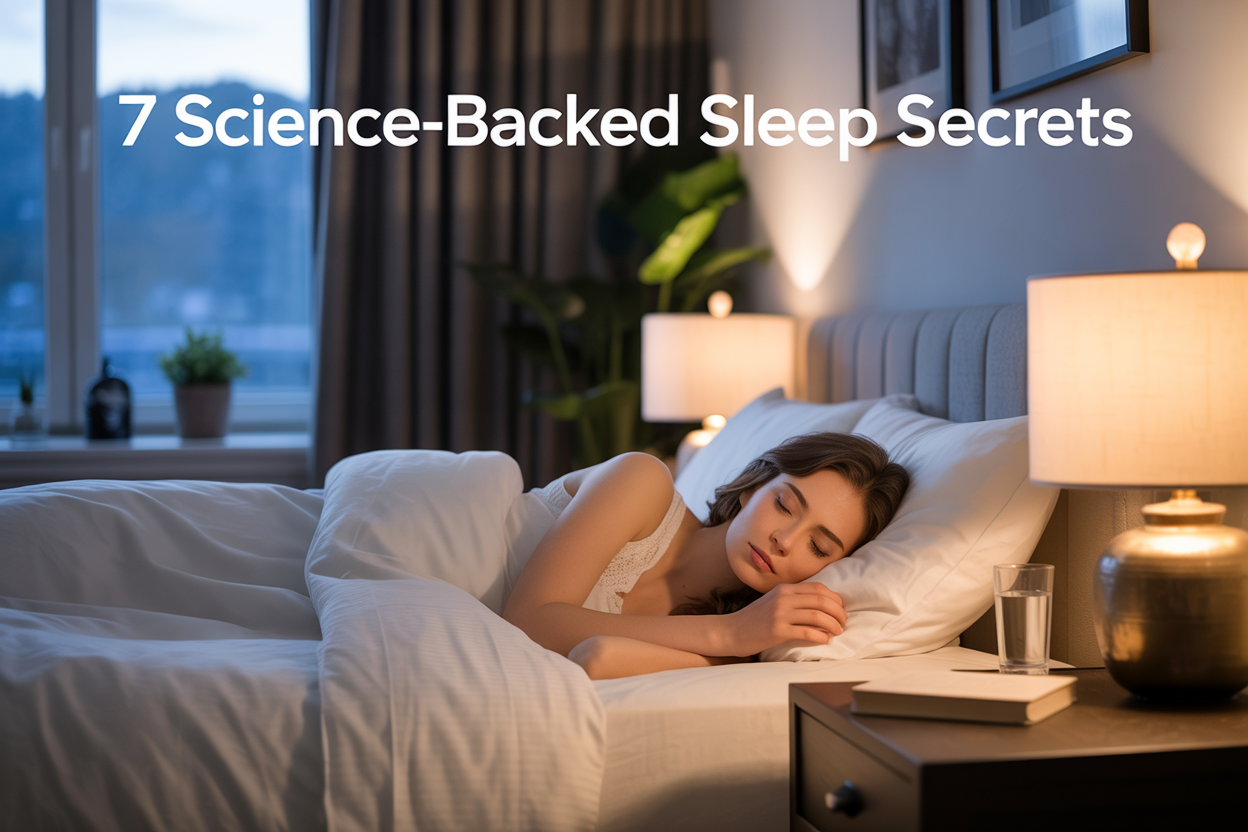
Getting quality sleep feels impossible when you're tossing and turning every night. Poor sleep affects millions of people who struggle with falling asleep, staying asleep, or waking up feeling exhausted.
This guide is for anyone tired of counting sheep and ready to try science-backed sleep strategies that actually work. You'll discover proven methods to transform your nights from restless to restorative.
We'll cover how to sleep better through seven key areas. You'll learn to optimize your sleep environment by controlling temperature, light, and noise levels that sabotage your rest. We'll explore circadian rhythm optimization using strategic light exposure to reset your internal clock naturally. You'll also discover sleep schedule consistency techniques and bedtime routine ideas that train your brain to wind down on command.
These aren't generic tips you've heard before. Each strategy comes from sleep research and real-world results that help you fall asleep faster and wake up refreshed.
Optimize Your Sleep Environment for Maximum Rest
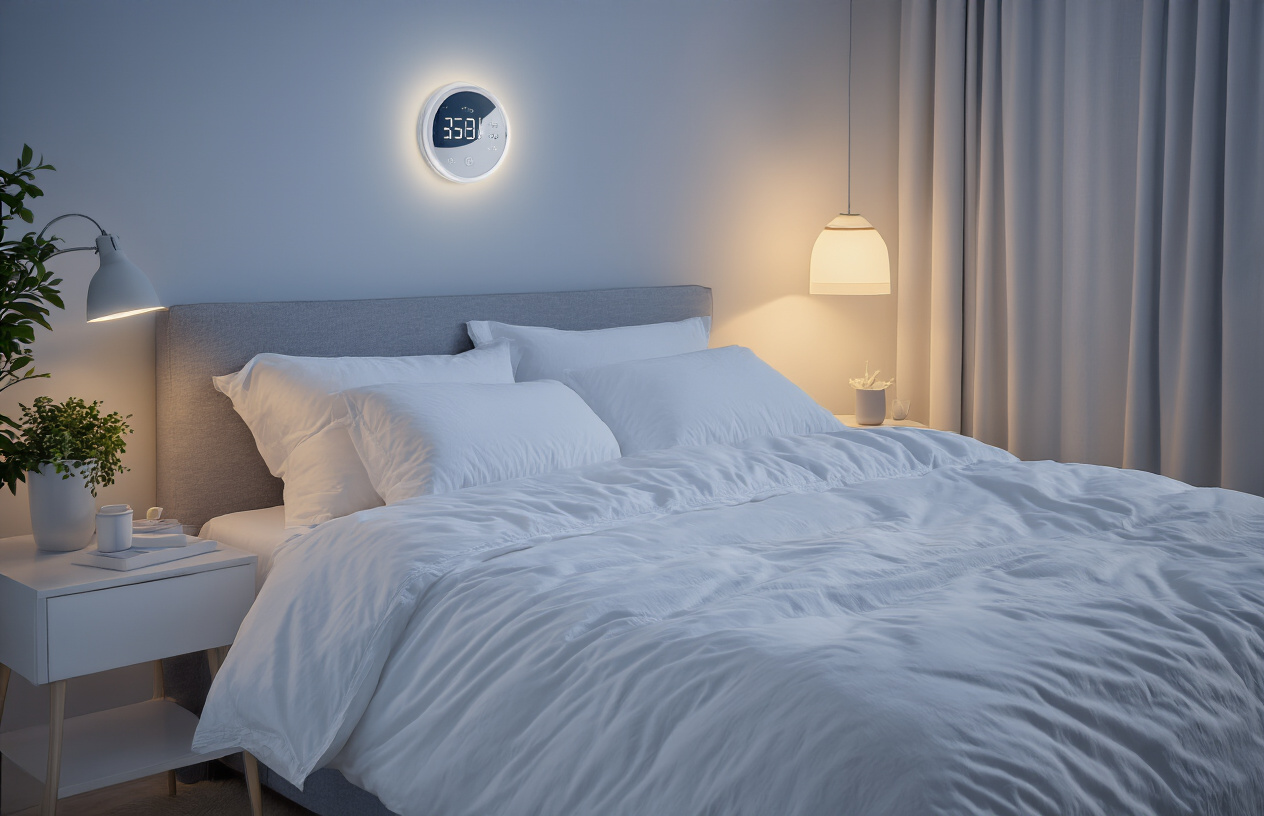
Control room temperature between 60-67 degrees Fahrenheit
Your body naturally drops its core temperature by about 2-3 degrees when preparing for sleep. This biological cooling process signals your brain that it's time to rest. When your bedroom is too warm, you're essentially fighting against this natural mechanism, making it harder to fall asleep and stay asleep throughout the night.
Research consistently shows that the sweet spot for optimal sleep quality lies between 60-67 degrees Fahrenheit (15-19°C), with most people finding 65°F ideal. At this temperature range, your body can efficiently shed heat through your extremities, allowing your core temperature to drop comfortably.
If you're dealing with a partner who prefers different temperatures, consider using separate blankets or a mattress with dual temperature zones. Cooling mattress toppers and breathable bedding materials like bamboo or linen can also help maintain the perfect sleep temperature without cranking up the AC.
Eliminate light sources and invest in blackout curtains
Even tiny amounts of light can disrupt your sleep quality by interfering with melatonin production. Your brain's pineal gland is incredibly sensitive to light exposure, and even the glow from a digital clock or streetlight filtering through your window can signal your body to stay alert.
Blackout curtains are one of the best investments you can make for better sleep. Look for curtains with a tight weave or thermal backing that blocks nearly 100% of outside light. For an even more effective approach, consider layering blackout curtains with room-darkening shades.
Don't forget about the sneaky light sources inside your bedroom. Cover or remove LED lights from electronics, use tape to block charging indicator lights, and consider switching to a traditional analog alarm clock. If you need some light for safety during nighttime bathroom trips, use a red-light nightlight, which has minimal impact on melatonin production.
Reduce noise pollution with earplugs or white noise machines
Sudden sounds and inconsistent noise levels can jolt you awake or prevent you from reaching deeper sleep stages. Your brain continues processing sounds even while you sleep, so creating a consistently quiet environment is crucial for restorative rest.
White noise machines work by creating a consistent sound blanket that masks disruptive noises like traffic, neighbors, or household sounds. The steady, predictable nature of white noise helps your brain tune out irregular sounds that might otherwise wake you. Popular alternatives include brown noise (deeper, more rumbling) or pink noise (softer than white noise), which some people find more soothing.
High-quality foam earplugs can reduce noise by 25-33 decibels and are particularly effective for light sleepers or those living in noisy environments. Silicone earplugs offer a more comfortable fit for side sleepers, while custom-molded earplugs provide the best noise reduction for chronic noise issues.
Choose the right mattress and pillows for your sleep position
Your sleep position determines the kind of support your body needs to maintain proper spinal alignment throughout the night. The wrong mattress or pillow can create pressure points, leading to tossing and turning that fragments your sleep.
Side sleepers (about 74% of people) need a medium to medium-soft mattress that contours to their hips and shoulders while supporting their waist. A thicker, firmer pillow helps keep the head aligned with the spine.
Back sleepers benefit from medium-firm mattresses that support the natural curve of the spine. A medium-height pillow prevents the head from tilting too far forward or back.
Stomach sleepers need firmer mattresses to prevent their hips from sinking too deeply, which can strain the lower back. A thin, soft pillow or no pillow at all helps maintain neck alignment.
| Sleep Position | Mattress Firmness | Pillow Type |
|---|---|---|
| Side | Medium to Medium-Soft | Thick, Firm |
| Back | Medium-Firm | Medium Height |
| Stomach | Firm | Thin or No Pillow |
Replace your mattress every 7-10 years and pillows every 1-2 years to maintain proper support and hygiene. Memory foam, latex, and hybrid mattresses each offer different benefits, so consider your specific needs, budget, and any temperature preferences when making your choice.
Master Your Circadian Rhythm Through Light Exposure
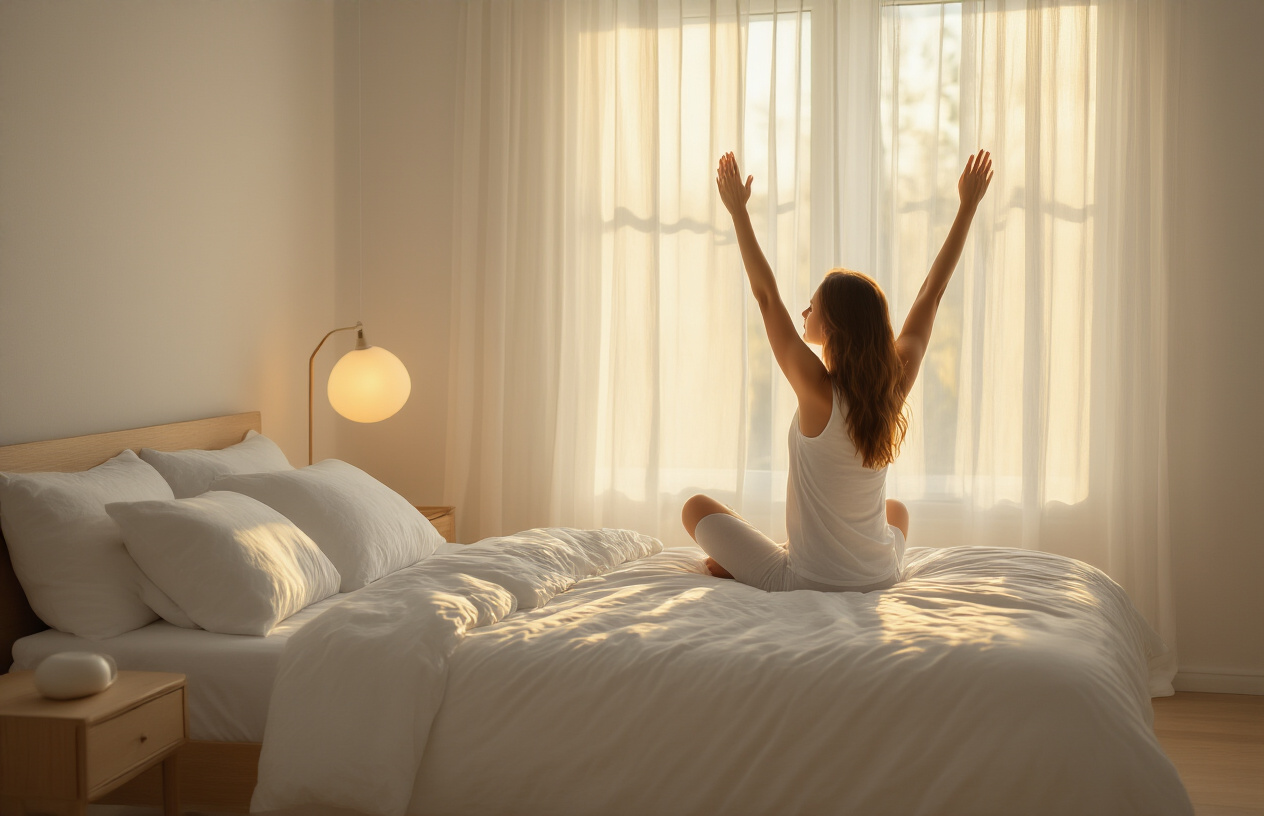
Get Bright Natural Light Within 30 Minutes of Waking
Your internal clock relies on light as its primary signal to stay synchronized with the 24-hour day. Getting bright natural light exposure within 30 minutes of waking acts like a reset button for your circadian rhythm, triggering the production of cortisol to help you feel alert and energized.
Step outside for 10-15 minutes of morning sunlight, even on cloudy days. The light intensity outdoors is typically 10-100 times brighter than indoor lighting, making it incredibly effective for circadian rhythm optimization. If you can't get outside, position yourself near a large window or invest in a light therapy box that delivers 10,000 lux.
The timing matters just as much as the intensity. Morning light exposure helps suppress melatonin production and signals your brain that it's time to be awake. This natural process also sets a timer for melatonin release later in the evening, making it easier to fall asleep at your desired bedtime.
For shift workers or those dealing with seasonal affective patterns, maintaining this morning light ritual becomes even more critical for sleep quality improvement.
Limit Blue Light Exposure 2-3 Hours Before Bedtime
Blue light from screens, LED bulbs, and electronic devices can seriously mess with your body's natural wind-down process. This wavelength of light tricks your brain into thinking it's still daytime, suppressing melatonin production and keeping you wired when you should be getting sleepy.
Create a digital sunset by turning off phones, tablets, computers, and televisions 2-3 hours before your target bedtime. If you absolutely must use devices, wear blue light blocking glasses or use built-in night mode settings that filter out blue wavelengths.
Replace overhead LED lights with warmer, dimmer alternatives during evening hours. Many people find that switching to table lamps with warm bulbs helps create a more sleep-friendly atmosphere. Smart bulbs that automatically adjust color temperature throughout the day can make this transition seamless.
Consider your bedroom environment too. Even small lights from alarm clocks, charging cables, or electronics can interfere with deep sleep. Cover or remove these light sources to create the darkest possible environment.
Use Dim Red Lighting in the Evening Hours
Red light has the least impact on melatonin production, making it the perfect choice for evening activities when you still need some visibility. Unlike blue or white light, red wavelengths don't send wake-up signals to your brain, allowing your natural sleep hormones to flow freely.
Install red night lights in hallways, bathrooms, and bedrooms for safe navigation without disrupting your circadian rhythm. Red reading lights or book lights allow you to enjoy evening activities without compromising your sleep schedule consistency.
Many people discover that red light therapy can actually enhance their bedtime routine ideas. The warm, gentle glow creates a calming atmosphere that psychologically signals the transition from day to night. Some research suggests that red light exposure may even support cellular repair processes that occur during sleep.
Salt lamps provide another source of warm, amber light that won't interfere with melatonin production. While not technically red light, their warm glow falls into the same sleep-friendly spectrum and adds a cozy ambiance to any room.
Establish a Consistent Sleep Schedule That Works
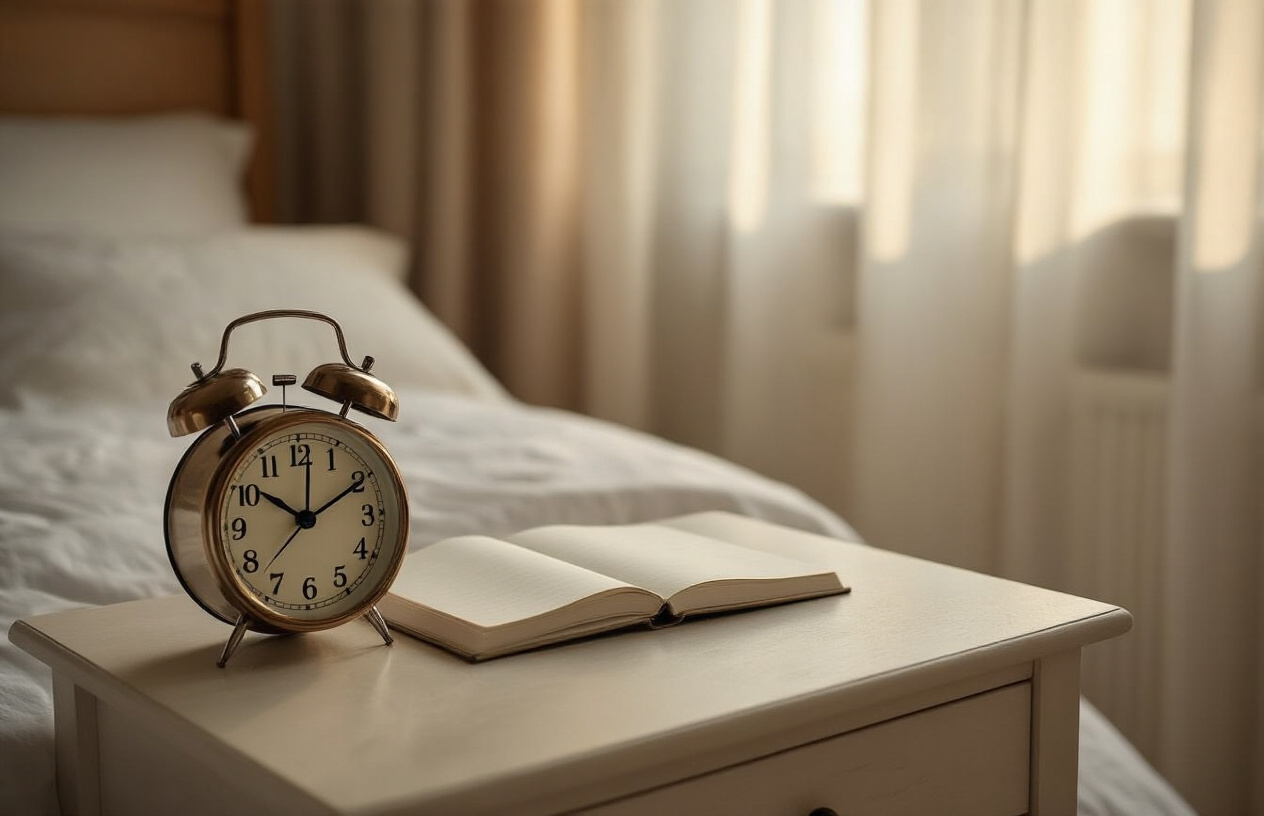
Go to bed and wake up at the same time every day
Your body craves predictability more than you might realize. When you maintain consistent sleep and wake times, you're essentially training your internal clock to work like a well-oiled machine. This practice strengthens your circadian rhythm optimization and makes falling asleep and waking up feel effortless.
Pick a bedtime that allows for 7-9 hours of sleep and stick to it religiously. Your wake time matters just as much – even if you went to bed late the night before, resist the urge to sleep in. This might feel brutal at first, but your body will thank you within a week or two as your natural sleep-wake cycle stabilizes.
Avoid weekend sleep schedule disruptions
Weekend sleep-ins might feel like a reward for surviving the work week, but they're secretly sabotaging your sleep quality improvement efforts. Scientists call this phenomenon "social jet lag" – you're basically putting your body through the equivalent of traveling across time zones every weekend.
Sleeping in on Saturday and Sunday throws off your carefully calibrated internal clock, making Monday mornings feel like torture. Instead of catching up on sleep by sleeping late, focus on getting to bed earlier during the week. If you absolutely need extra rest on weekends, limit yourself to just one additional hour of sleep.
Gradually adjust your bedtime by 15-minute increments
Dramatic sleep schedule changes rarely stick because they shock your system. If you're currently a night owl trying to become an early bird, don't attempt to shift your bedtime by several hours overnight. Your body will rebel, and you'll likely abandon your better sleep tips before they have a chance to work.
Start by moving your bedtime 15 minutes earlier every few days. This gradual approach allows your circadian rhythm to adapt naturally without causing major disruption to your daily routine. The same principle applies to wake times – shift them slowly and steadily.
Here's a sample adjustment schedule:
| Week | Bedtime Shift | Wake Time Shift |
|---|---|---|
| 1 | 15 minutes earlier | 15 minutes earlier |
| 2 | 30 minutes earlier | 30 minutes earlier |
| 3 | 45 minutes earlier | 45 minutes earlier |
| 4 | 60 minutes earlier | 60 minutes earlier |
Create accountability systems to maintain consistency
Building new sleep hygiene habits requires more than just willpower – you need systems that make consistency easier to maintain. Set phone alarms not just for waking up, but also for your bedtime wind-down routine. This creates a clear signal that it's time to start preparing for sleep.
Track your sleep schedule using a simple journal or smartphone app. Seeing your patterns visualized helps identify when you're drifting off course and reinforces positive habits when you're doing well. Consider sharing your sleep goals with a family member or roommate who can gently remind you when you're staying up too late.
Some people find success in creating "sleep appointments" with themselves, treating bedtime as seriously as they would any important meeting. Others benefit from removing temptations by setting their devices to "Do Not Disturb" mode or keeping them in another room entirely. Find the accountability method that resonates with your personality and lifestyle.
Develop a Pre-Sleep Routine That Signals Bedtime
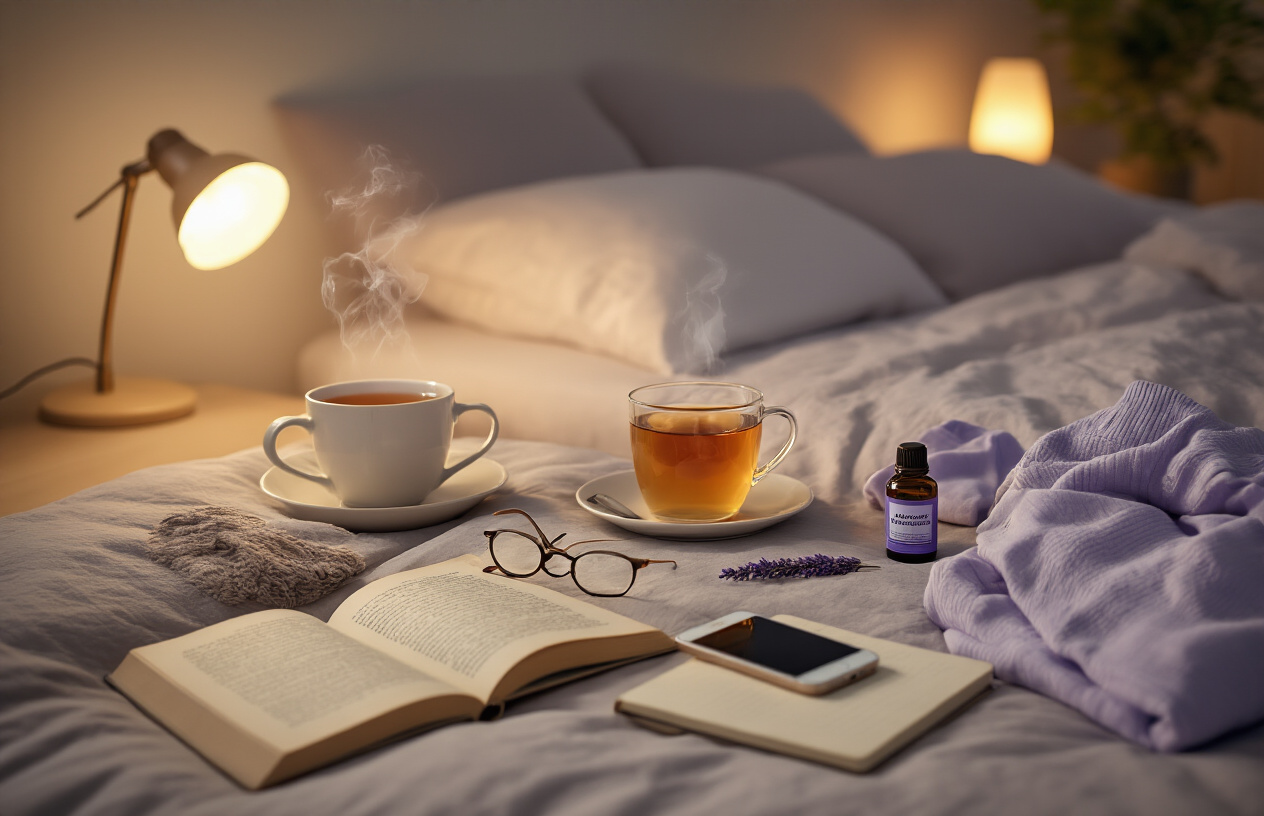
Start winding down 1-2 hours before sleep
Your brain needs time to shift from the high-energy demands of your day into sleep mode. Think of this wind-down period as creating a gentle bridge between your active hours and restful sleep. Starting this process 1-2 hours before your intended bedtime gives your nervous system adequate time to slow down naturally.
During this crucial window, dim the lights throughout your home to signal your brain that nighttime is approaching. Bright overhead lighting tricks your body into thinking it's still daytime, suppressing melatonin production. Switch to warm, soft lighting from table lamps or even candlelight if you want to create an especially calming atmosphere.
Put away electronic devices or use blue light filters if you absolutely must check something. The blue light from phones, tablets, and computers disrupts your circadian rhythm and makes falling asleep significantly harder. Instead, choose activities that naturally quiet your mind: reading a physical book, listening to calming music, or gentle stretching.
Create a mental separation between day and night by changing into comfortable sleepwear. This simple act sends a powerful psychological signal that work time is over and rest time has begun. Some people find that keeping a notepad nearby helps them jot down any lingering thoughts or tomorrow's tasks, clearing their minds for sleep.
Practice relaxation techniques like deep breathing or meditation
Deep breathing activates your parasympathetic nervous system, which controls your body's rest-and-digest response. The 4-7-8 breathing technique works particularly well for bedtime routine ideas. Inhale through your nose for 4 counts, hold your breath for 7 counts, then exhale completely through your mouth for 8 counts. Repeat this cycle 3-4 times.
Progressive muscle relaxation offers another powerful tool for better sleep tips. Start with your toes and systematically tense each muscle group for 5 seconds, then release completely. Work your way up through your legs, torso, arms, and face. This technique helps you identify and release physical tension you might not even realize you're carrying.
Mindfulness meditation doesn't require years of practice to be effective. Simply focus on your breath, noticing each inhale and exhale without trying to change anything. When your mind wanders (and it will), gently guide your attention back to your breathing. Even 5-10 minutes of this practice can significantly improve sleep quality.
Guided sleep meditations provide structure for beginners. Many apps offer specialized programs designed specifically for bedtime, featuring soothing voices and calming background sounds that help quiet racing thoughts.
Take a warm bath or shower to lower core body temperature
This might seem counterintuitive, but warming your body before bed actually helps you fall asleep faster. When you step out of a warm bath or shower, your core body temperature drops rapidly. This temperature decline mirrors your body's natural sleep preparation process and signals your brain to release sleep-inducing hormones.
The optimal water temperature sits around 104-108°F (40-42°C), and timing matters. Take your warm bath or shower 60-90 minutes before you want to fall asleep. This gives your body enough time to cool down and reach the lower core temperature that promotes drowsiness.
Adding Epsom salts to your bath provides the bonus of muscle relaxation through magnesium absorption. Lavender essential oil creates an aromatherapy experience that many people find deeply calming. Keep the bathroom lighting dim and consider playing soft, instrumental music to enhance the relaxation response.
If you're short on time, even a 5-minute warm shower can be effective. Focus on letting the warm water run over your neck and shoulders, where many people hold tension. Follow up with cool air in your bedroom to accelerate the cooling process that promotes sleep.
Time Your Food and Drink Intake Strategically
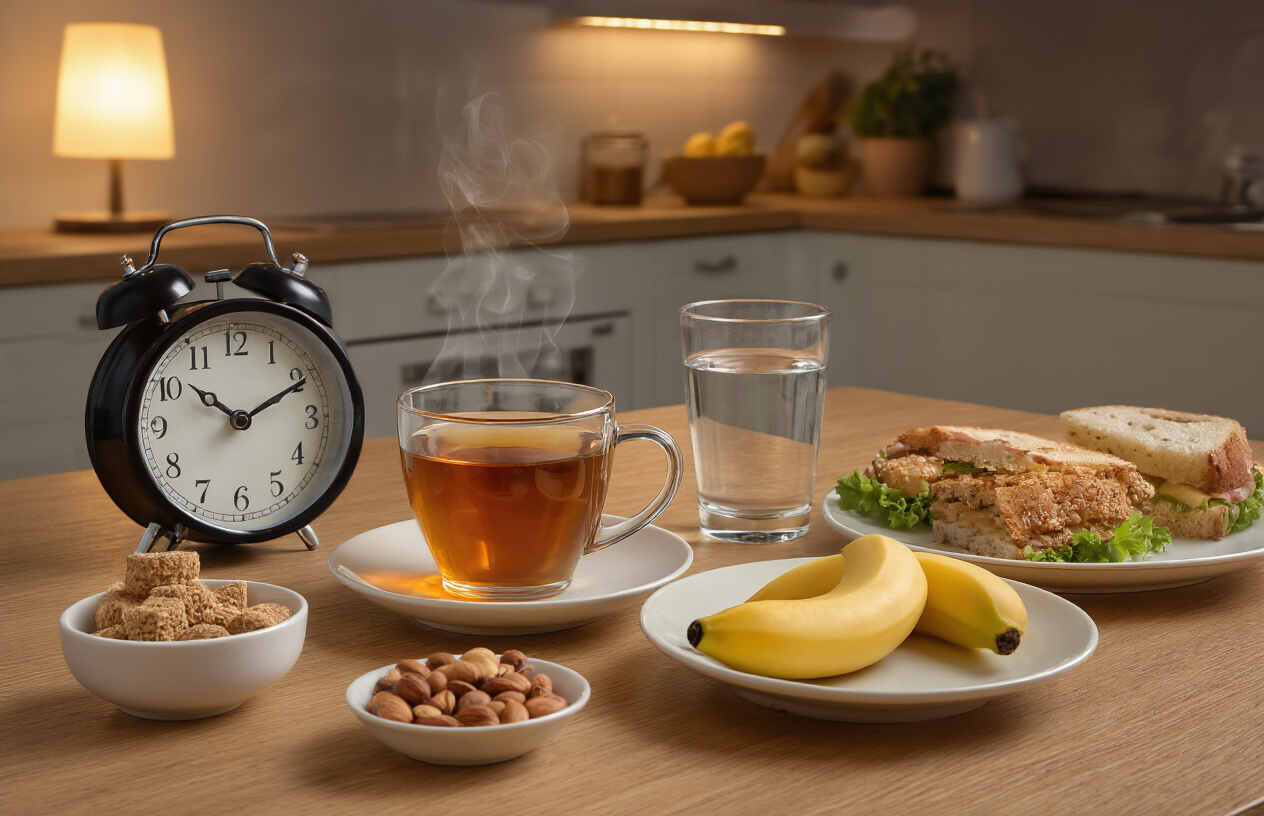
Stop eating large meals 3-4 hours before bedtime
Your digestive system needs time to work through a big meal, and when you eat late, you're essentially asking your body to do two conflicting things at once: digest food and prepare for sleep. This creates a biological tug-of-war that often leaves you tossing and turning.
When you consume a large meal close to bedtime, your core body temperature rises as your metabolism kicks into high gear. Since your body naturally needs to cool down to trigger sleepiness, this digestive heat wave works against your natural sleep patterns. The result? You'll likely find yourself staring at the ceiling while your stomach churns away.
Research shows that eating within three hours of sleep significantly reduces sleep quality and can cause more frequent nighttime awakenings. Your body produces less melatonin when it's busy processing food, which directly impacts your ability to fall asleep quickly.
If you must eat dinner later than ideal, choose lighter options like lean proteins with vegetables rather than heavy, fatty, or spicy foods that take more energy to digest.
Limit caffeine consumption after 2 PM
Caffeine has a half-life of 5-6 hours, meaning that afternoon cup of coffee at 3 PM still has half its caffeine content coursing through your system at 8 or 9 PM. This hidden stimulation can sabotage your sleep quality improvement efforts without you even realizing it.
Many people don't connect their evening restlessness to that mid-afternoon pick-me-up, but the science is clear: caffeine consumed after 2 PM significantly disrupts both sleep onset and deep sleep stages. Even if you manage to fall asleep, the caffeine in your system reduces the restorative quality of your rest.
Beyond coffee, watch out for hidden caffeine sources that can trip up your better sleep tips strategy:
-
Chocolate (especially dark chocolate)
-
Tea (including green and black varieties)
-
Soft drinks and energy drinks
-
Some medications (check labels for caffeine content)
-
Decaf coffee (contains small amounts of caffeine)
Your caffeine sensitivity also increases with age, so you might need to push that 2 PM cutoff even earlier if you're over 40. Some people find switching to herbal teas in the afternoon helps maintain their energy without compromising their sleep hygiene habits.
Avoid alcohol within 4 hours of sleep
While alcohol might make you feel drowsy initially, it's actually one of the sneakiest sleep disruptors. That nightcap might help you fall asleep faster, but it's setting you up for a fragmented, unrefreshing night.
Alcohol blocks REM sleep during the first part of the night, which is why you might wake up feeling groggy even after what seemed like a full night's rest. As alcohol metabolizes, it causes a rebound effect that leads to lighter sleep and more frequent awakenings in the second half of the night.
The four-hour rule gives your liver enough time to process most of the alcohol before you hit the pillow. Here's what happens when you follow this guideline:
| Timing | Sleep Impact |
|---|---|
| Alcohol 4+ hours before bed | Minimal sleep disruption |
| Alcohol 2-3 hours before bed | Reduced deep sleep, more awakenings |
| Alcohol 1-2 hours before bed | Significant REM disruption |
| Alcohol right before bed | Poor sleep quality, frequent waking |
If you enjoy an evening drink, try moving it earlier or switching to a non-alcoholic alternative after dinner.
Choose sleep-promoting snacks if needed before bed
Sometimes hunger pangs strike right before bedtime, and going to bed hungry can be just as disruptive as eating a large meal. The key is choosing the right foods that support your natural sleep remedies approach.
The best bedtime snacks combine tryptophan (an amino acid that promotes sleep) with complex carbohydrates that help deliver this sleepy amino acid to your brain. These combinations work as part of your science-backed sleep strategies:
Top sleep-friendly snacks:
-
Small bowl of oatmeal with banana
-
Greek yogurt with a handful of almonds
-
Whole grain toast with a thin layer of almond butter
-
Tart cherry juice (natural source of melatonin)
-
Small portion of turkey with crackers
Foods to avoid before bed:
-
Spicy foods that can cause heartburn
-
High-sugar treats that spike energy
-
Fatty foods that slow digestion
-
Large portions of any food
Keep bedtime snacks small (under 200 calories) and finish eating at least 30 minutes before lying down. This gives your body enough time to begin the initial digestion process without interfering with your sleep onset.
Incorporate Physical Activity for Better Sleep Quality
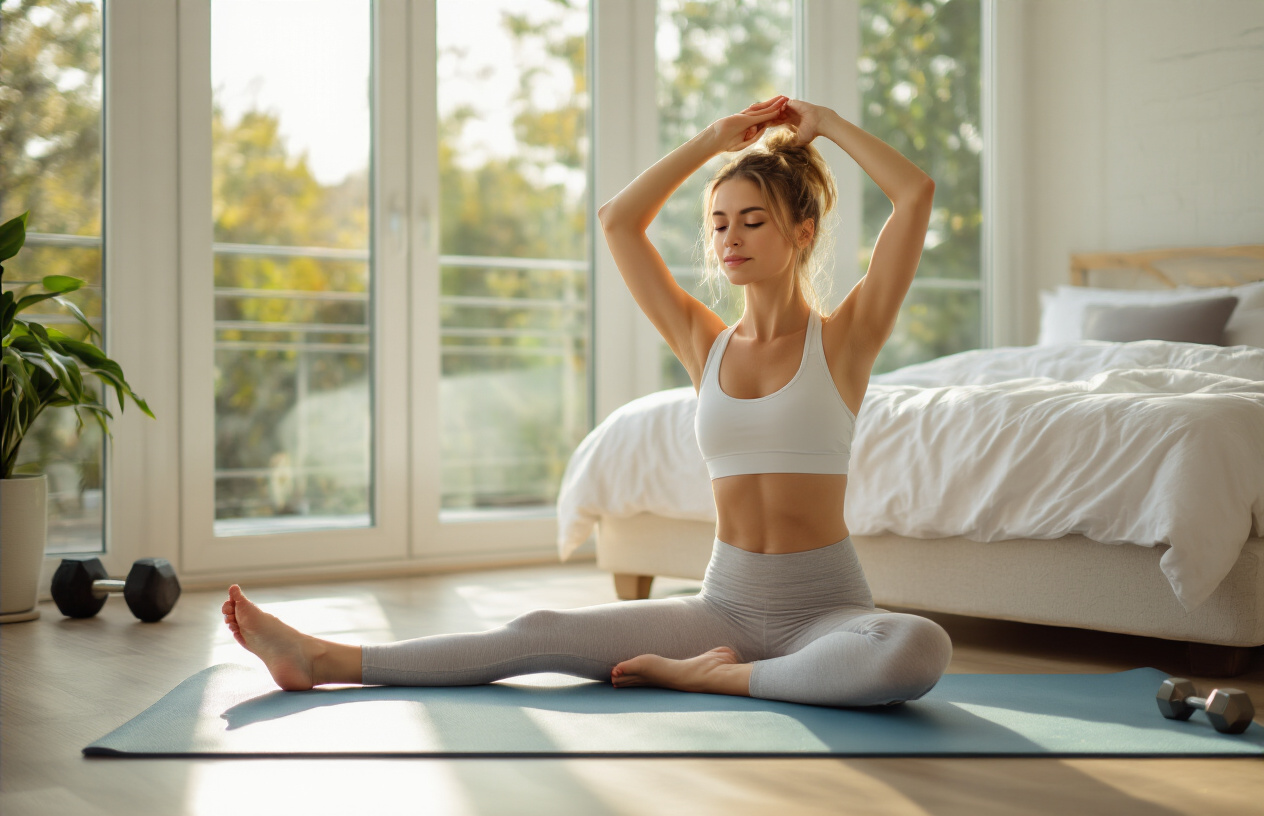
Exercise regularly but not within 4 hours of bedtime
Regular physical activity acts as a powerful natural sleep aid, improving both how quickly you fall asleep and the quality of your rest. When you exercise consistently, your body temperature rises during the workout and then drops afterward, mimicking the natural temperature decline that signals bedtime to your brain. This process helps regulate your circadian rhythm and makes it easier to drift off when your head hits the pillow.
The timing of your workouts plays a crucial role in sleep quality improvement. While morning and afternoon exercise sessions can enhance your nighttime rest, vigorous activities within four hours of bedtime can have the opposite effect. Late-evening workouts elevate your heart rate, body temperature, and stress hormones like cortisol and adrenaline, making it harder for your nervous system to wind down. Your body needs time to return to its baseline state before sleep becomes possible.
Aim for at least 150 minutes of moderate aerobic activity or 75 minutes of vigorous exercise per week, spread across several days. Activities like brisk walking, swimming, cycling, or strength training all contribute to better sleep patterns. Even light exercise like a 20-minute morning walk can make a noticeable difference in your sleep quality that same night.
Try gentle yoga or stretching in the evening
Evening yoga and stretching create the perfect bridge between your active day and restful night. These gentle movements help release physical tension accumulated throughout the day while activating your parasympathetic nervous system, which controls your body's rest-and-digest response. Unlike intense workouts, these calming activities actually prepare your body for sleep rather than energizing it.
Specific poses like child's pose, legs-up-the-wall, and gentle spinal twists can reduce cortisol levels and lower your heart rate. Focus on deep, slow breathing during each stretch to amplify the relaxation benefits. A simple 10-15 minute routine can work wonders - you don't need an hour-long session to see results.
Create a consistent evening routine that includes 3-4 basic stretches or yoga poses. Hold each position for 30-60 seconds while breathing deeply. This practice not only improves flexibility but also serves as a mental cue that bedtime is approaching, helping your brain transition from daytime alertness to nighttime calm.
Take short walks after dinner to aid digestion
Post-dinner walks offer a gentle way to support both digestion and sleep quality. Walking helps your body process food more efficiently, preventing the discomfort that can keep you tossing and turning later. When you eat a large meal and immediately lie down, your digestive system works harder, potentially causing heartburn or indigestion that interferes with rest.
A leisurely 10-20 minute walk around your neighborhood or even indoors helps regulate blood sugar levels and prevents the energy crash that sometimes follows large meals. This light movement also exposes you to fresh air and can provide a peaceful transition between dinner and your bedtime routine.
Keep these walks gentle and relaxing - this isn't the time for power walking or intense cardio. Think of it as moving meditation that helps your body prepare for the night ahead. Many people find that this simple habit becomes one of their favorite parts of the day, offering quiet time to reflect or connect with family members who join them on these evening strolls.
Manage Stress and Racing Thoughts Before Bed
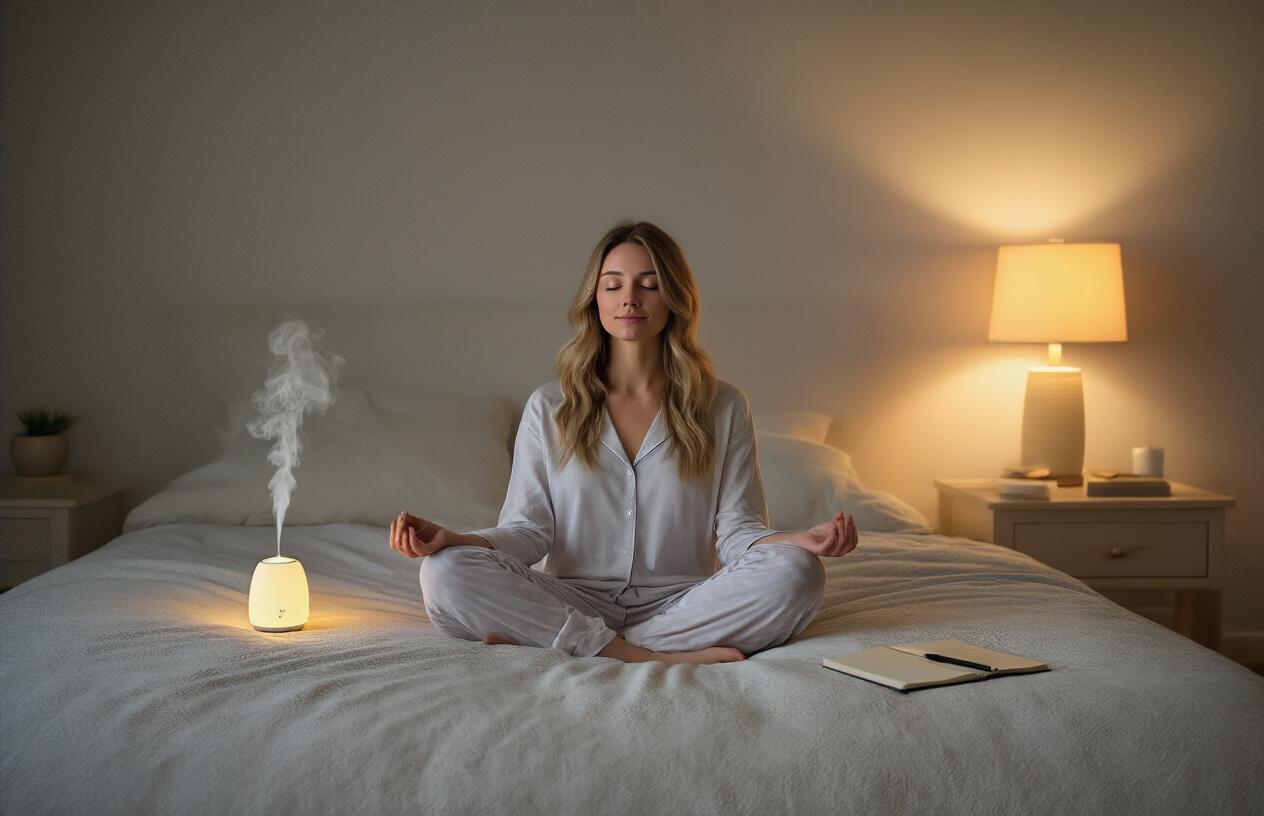
Keep a bedside journal to dump worries and thoughts
A cluttered mind is sleep's biggest enemy. When you lie down and your head hits the pillow, your brain suddenly decides it's the perfect time to replay every conversation from the day or worry about tomorrow's deadlines. This mental noise sabotages your ability to fall asleep and stay asleep.
The brain dump technique involves writing down everything on your mind before bed. Keep a notebook and pen next to your bed, not your phone. Spend 5-10 minutes writing down:
-
Tomorrow's tasks and priorities
-
Worries or concerns you can't control tonight
-
Random thoughts bouncing around your head
-
Things you're grateful for from the day
The physical act of writing helps transfer these thoughts from your active mind to paper, creating mental space for rest. Studies show that people who practice expressive writing before bed fall asleep significantly faster than those who don't.
Practice progressive muscle relaxation techniques
Your body holds tension from the day in ways you might not realize. Progressive muscle relaxation (PMR) systematically releases this physical stress, making it easier for your mind to follow suit.
Here's how to practice PMR:
-
Start with your toes - tense them for 5 seconds, then release completely
-
Move up to your calves, thighs, and glutes
-
Progress through your abdomen, chest, and shoulders
-
Finish with your arms, hands, neck, and facial muscles
The key is the contrast between tension and relaxation. When you deliberately tense a muscle group and then release it, you create a deeper state of relaxation than if you simply tried to relax without the tension phase first.
This technique works because it gives your mind something specific to focus on instead of racing thoughts. The methodical progression through your body creates a meditative state that naturally leads to drowsiness.
Use guided meditation apps designed for sleep
Sleep-specific meditation apps have revolutionized bedtime routines for millions of people struggling with racing minds. Unlike general meditation, sleep meditations are designed to guide you into unconsciousness, not heightened awareness.
Top features to look for in sleep meditation apps:
-
Sleep stories: Boring, monotonous narratives that distract your mind
-
Body scan meditations: Similar to PMR but with guided verbal cues
-
Ambient soundscapes: Rain, ocean waves, or white noise
-
Timer settings: Sessions that fade out as you fall asleep
Popular options include Calm, Headspace, and Insight Timer. Many offer free content, so you can experiment with different voices and styles. Some people respond better to male voices, others to female voices. Some prefer fantasy stories, while others like nature documentaries.
The magic happens when you find a narrator whose voice becomes a sleep trigger for your brain. After consistent use, just hearing that familiar voice signals to your nervous system that it's time to wind down.
Try the 4-7-8 breathing technique to calm your mind
This simple breathing pattern acts like a natural sedative for your nervous system. Developed by Dr. Andrew Weil, the 4-7-8 technique works by activating your parasympathetic nervous system - the "rest and digest" mode that promotes relaxation and sleep.
How to practice 4-7-8 breathing:
-
Exhale completely through your mouth
-
Close your mouth and inhale through your nose for 4 counts
-
Hold your breath for 7 counts
-
Exhale completely through your mouth for 8 counts
-
Repeat for 3-4 cycles
The extended exhale is crucial - it signals to your vagus nerve that you're safe and can relax. The counting gives your mind something specific to focus on, breaking the cycle of anxious thoughts.
Start with just a few cycles. Some people feel slightly lightheaded at first, which is normal. With practice, this breathing pattern becomes automatic and incredibly effective at shifting your mental state from alert to drowsy within minutes.
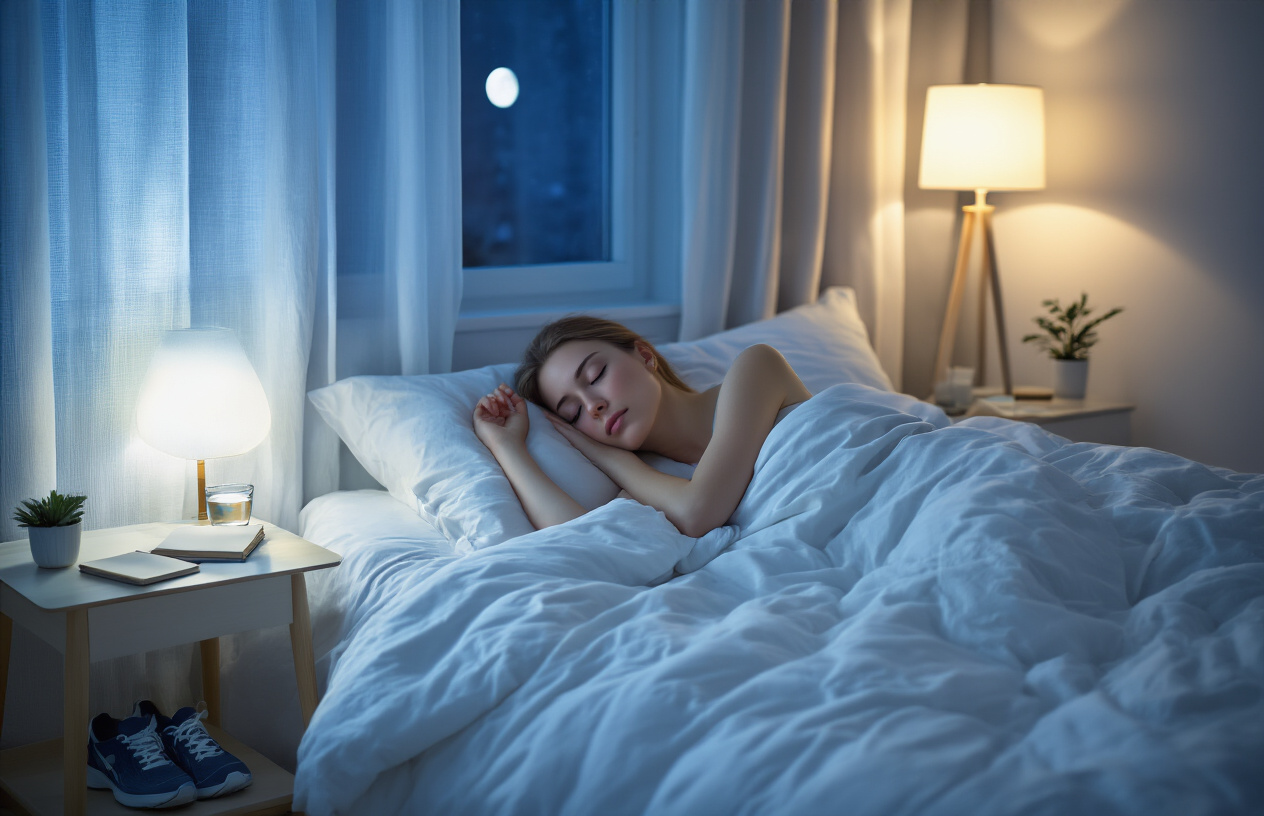
Getting quality sleep doesn't have to be complicated. The seven strategies covered here work because they align with how your body naturally wants to rest. Creating the right environment, syncing with your internal clock through light exposure, and sticking to consistent bedtimes all help your brain recognize when it's time to wind down. Add a calming pre-sleep routine, watch your eating and drinking timing, stay active during the day, and find ways to quiet your mind before bed.
Start with just one or two of these techniques rather than trying to overhaul everything at once. Maybe begin by darkening your bedroom and setting a consistent bedtime, then gradually add other elements like a relaxing routine or limiting late-night snacks. Your sleep will improve step by step, and better rest means better days ahead. Your body knows how to sleep well – these science-backed approaches simply remove the obstacles standing in its way.







